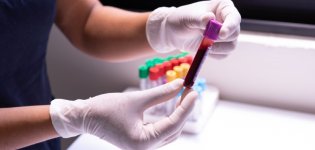Are you over 50 and still haven't had a urological check-up?
WHAT IS EARLY DIAGNOSIS OF PROSTATE CANCER?
Blood markers and prostate examination are the main tools for detecting prostate cancer.
PHASE 1 - Specialist visit and biomarker analysis
A urologist specialising in the diagnosis of prostate pathologies will visit you and, if necessary, perform a physical examination through a rectal exam and request a biochemical diagnosis. From the age of 50 onwards - and in some cases earlier - it is advisable to carry out blood tests in which certain values are measured. One of the most relevant is the prostate-specific antigen or PSA. This marker helps to predict the risk of prostate cancer and serves to adapt the visits and the diagnostic process.
PHASE 2 - Prostate examination
A prostate examination is further divided into two processes: imaging and biopsy. Imaging tests can accurately identify prostate lesions and, in some cases on their own and others in conjunction with biopsy, help to differentiate between high-risk and low-risk lesions. Thus, a prostate examination can diagnose lesions, but also identify the degree of severity and help to define the subsequent treatment.
Imaging tests

Prostate ultrasound
Transrectal ultrasound of the prostate is an ultrasound test that makes it possible to verify the size and morphology of the prostate gland. In addition, although not with the precision of magnetic resonance imaging, it allows the presence of lesions, inflammation or abnormal formations to be assessed.

Magnetic resonance imaging
Prostate MRI is an imaging test used to study the shape, size and signal of the prostate. In the event of changes in the size, shape or signal of the prostate gland, the radiologist will report on the possible presence of inflammation (prostatitis), enlargement (prostate hyperplasia) or a tumour (prostate cancer). In this regard, he will not only describe the presence or absence of lesions but will also report on the likelihood of these being malignant or the degree of malignancy.
With prostate MRI we can diagnose around 85% of prostate cancers, especially the larger and more aggressive ones.
In addition, MRI allows us to perform targeted biopsies and fusion biopsies, which are much more precise and accurate and less invasive for the patient.
Prostate biopsy
Prostate biopsy is a diagnostic test in which a sample of prostate tissue is taken for laboratory analysis. It is usually performed in the presence of high PSA, suspicious rectal examination and/or suspected lesions on imaging tests.

Transrectal biopsy
Transrectal prostate biopsy is usually performed under local anaesthesia. Ultrasound guidance allows the practitioner to be more precise and to take the sample in the area of the affected prostate.

Directed biopsy
While conventional transrectal prostate biopsy uses ultrasound to identify the affected area, targeted biopsy uses magnetic resonance imaging (MRI). The MRI-guided biopsy is much more precise and provides more detailed images of the prostate.

Fusion biopsy
Fusion prostate biopsy is an outpatient procedure that allows prostate tissue samples to be obtained by combining MRI and ultrasound images. By combining the images from these tests, a three-dimensional model of the prostate is created, which offers the greatest possible precision in sampling, a more accurate diagnosis, better identification and analysis of lesions and, given that it is performed under local anaesthesia, greater comfort for the patient.
WHO SHOULD CONSIDER PROSTATE CANCER SCREENING?
The types of people who should consider an early diagnosis of prostate cancer are:
- All men aged 50 and over.
- When there is a family history of prostate cancer, screening should be brought forward to age 45.
- People with some specific genetic mutations should do so from the age of 40.
Do you need medical advice on the early diagnosis of prostate cancer, but you are not in Barcelona or cannot travel? If you wish, our professionals will attend to you via video conference, without you having to leave your home.
EARLY DIAGNOSIS OF PROSTATE CANCER IN DATA
- Around 30,000 new cases of prostate cancer are diagnosed every year in Spain.
- It is the third leading cause of cancer death in men, after lung and colorectal cancer.
- Ageing is the main factor associated with this disease.
- One in three men over 50 will get prostate cancer.
- Most cases are diagnosed at the localised stage and in high-income countries, less than 10% of prostate cancers will be diagnosed at the metastatic onset.
- When diagnosed at the localised stage, survival rates of up to 98% of cases are achieved.
PROSTATE CANCER TREATMENT
There are currently various treatments for localised prostate cancer, which vary depending on the degree of development of the disease and the patient's characteristics.

Prostate cancer surgery - Radical prostatectomy
The most commonly used when prostate cancer is not thought to have spread is radical prostatectomy. This treatment for prostate cancer involves surgery to remove the entire prostate gland and some of the surrounding tissue, such as the seminal vesicles. Sometimes nearby lymph nodes are also removed.

Radiotherapy
In some cases, radiotherapy may also be considered to treat the prostate without the need for prostate removal.

Other treatments
Other treatments that are also widely used are cryotherapy and focal therapy. In any case, the choice of one procedure or another will depend on the characteristics of the tumour and the patient.
When prostate cancer is diagnosed at a very localised stage, survival can be as high as 98% of cases. There is, however, a small percentage of patients who cannot be cured, but for whom there are treatments that can help increase survival and quality of life.
PROFESSIONALS WITH EXPERTISE IN PROSTATE DIAGNOSIS
BLOG

barnaclinic+ incorporates early diagnosis programmes for prostate and breast cancer
Cancer is one of the most common diseases. The great advances in medicine in recent years have made it possible to improve the survival rate of this disease. However, it is still the leading cause of death in the world today. One of the decisive factors for a good prognosis is the stage of development […]

barnaclínc+ launches its Medical Check-up unit
An early diagnosis is usually always synonymous with a better prognosis. Both because the pathology has not developed enough to cause irreparable damage and because in earlier stages it is possible to use less aggressive treatments that lead to a better and faster recovery. Medical reviews are a very useful tool for all of this, […]

Liquid biopsy shows its utility in the analysis of cancer
One of the big challenges in the treatment of cancer is its heterogeneity. Tumours can present different mutations and change with time, which means that not all treatments are effective or they generate resistance. That’s why it is important to carry out follow-ups that allow us to identify changes as they are produced. However, getting […]






